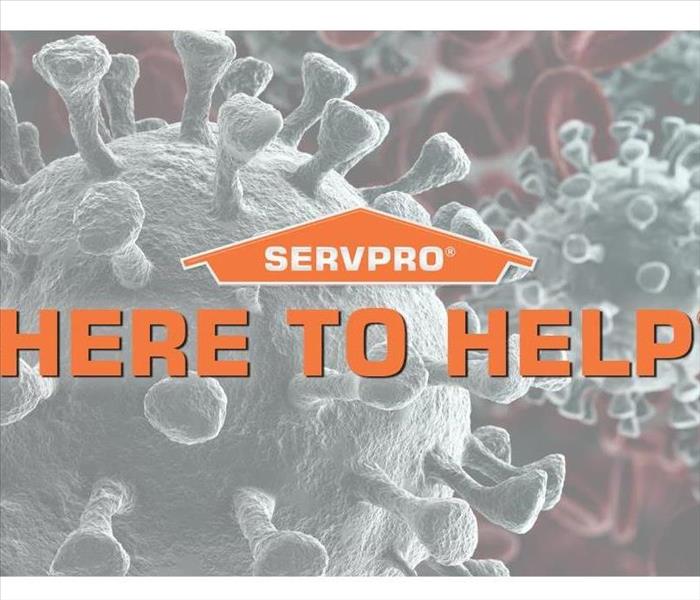Coronavirus Cleaning
4/23/2020 (Permalink)
SERVPRO of St. Clair Shores is now receiving a lot of phone calls from various businesses regarding Covid-19 cleanings prior to opening their business. We are Here to Help!
This is a general guideline for the proactive cleaning and disinfecting of surfaces to minimize the transmission of emergent viral pathogens including coronavirus disease 2019 (abbreviated “COVID-19”). This guide may be superseded by federal, state and local regulations. It is recommended before commencing any work that you contact your pollution insurance and workers compensation insurance provider to confirm coverage for emerging pathogen type work.
About Coronavirus
According to the U.S. Centers for Disease Control (CDC), coronaviruses (CoV) are a large family of viruses that cause illness ranging from the common cold to more severe diseases such as Middle East Respiratory Syndrome (MERS-CoV) and Severe Acute Respiratory Syndrome (SARS-CoV). A novel coronavirus (nCoV) is a new strain that has not been previously identified in humans. CDC is responding to an outbreak of respiratory disease caused by a novel (new) coronavirus that was first detected in Wuhan City, Hubei Province, China and which has now (as of this publication) been detected in 60 locations internationally, including cases in the United States. The virus has been named “SARS-CoV-2” and the disease it causes has been named “coronavirus disease 2019” (abbreviated “COVID-19”).i The CDC has setup a Coronavirus Disease 2019 (COVID-19) Situation Summary page to provide updated information as it becomes available, in addition to updated guidance.
The CDC has also provided information about how the virus potentially spreads. This is important knowledge for those creating cleanup plans for individual buildings and facilities. According to the CDC, their current understanding about how COVID-19 spreads is largely based on what is known about similar coronaviruses. COVID-19 is a new disease and there is more to learn about how it spreads, the severity of illness it causes, and to what extent it may spread in the United States. The virus is thought to spread mainly from person-to-person. This could be between people who are in close contact with one another (within about 6 feet) or through respiratory droplets produced when an infected person coughs or sneezes. These droplets can land in the mouths or noses of people who are nearby or possibly be inhaled into the lungs. It may be possible that a person can get COVID-19 by touching a surface or object that has the virus on it and then touching their own mouth, nose, or possibly their eyes, but this is not thought to be the main way the virus spreads.
Scope of Cleanup Protocol
This proactive cleanup protocol involves a customer that is requesting facility or structure cleaning and disinfection and the customer states that there is NO active known threat of SARS-CoV-2 contamination or exposure. This would be a proactive cleaning action driven from current, active events. In this scenario, the facility can be cleaned using the general guidelines provided within this document. Please note that these are general guidelines only. Building and spaces greatly differ. Each location will require individual planning.
The scope of work will be created and agreed upon by the customer and the SERVPRO franchise to ensure a set of agreeable expectations. The customer needs to acknowledge that cleaning and disinfecting will only apply to the current state of the structure and contents. This should be documented with the Request for Proactive Cleaning to Minimize the Transmission of Emerging Viral Pathogens (including Coronavirus) form. The structure would not be protected from future SARS-CoV-2 contamination if an infected person was to enter and occupy the building.
Exclusions to Cleanup Protocol
Beyond the scope of this cleanup protocol is a situation involving a Person Under Investigation (PUI). A PUI includes someone who is involved in a quarantine situation or has come in contact with someone who has been in a quarantine situation. Also, beyond the scope of this cleanup protocol is a situation involving a confirmed positive case of SARS-CoV-2. In both these situations, it is advised to not perform any work without contacting the proper governmental agency (CDC, Health Department, etc.). In these situations, the protocol/scope needs to be provided by the presiding governmental agency. Do not perform this work without that oversight in place.
Cleanup Scope of Work and Planning
The CDC encourages cleaning of high touch surfaces such as counters, tabletops, doorknobs, bathroom fixtures, toilets, phones, keyboards, tablets, and tables at a minimum. These same surfaces are mentioned in the CDCs guidance for commercial spaces as well.
Cleaning removes the soil and dirt that harbors the infectious agents, while disinfecting kills the remaining environmental pathogens. Cleaning is a necessary first step in disinfecting a surface. Both cleaning and disinfecting must be a part of your scope of work and plan.
• tables and chairs
• countertops
• cabinets and pulls
• doorknobs
• floors-hard surfaces/wood
• mats
• food contact surfaces
• light switches
• paper towel/napkin dispensers
• push doors
• bathroom stalls
• countertops
• cabinets/vanities and pulls
• doorknobs
• floors-hard surfaces/wood
• handrails
• light switches
• paper towel/napkin dispenser
• sink hardware
• sinks
• soap dispensers
• book covers and binders
• carpets
• chairs
• computer equipment
• countertops
• doorknobs
• floors- hard surfaces/wood
• small hard surface items
• light switches
• mats
• carpets
• chairs
• telephones
• computer equipment
• countertops
• doorknobs
• floors- hard surfaces/wood
• light switches
• rugs
• shared office equipment
• tabletops/desktops
• water fountains






 24/7 Emergency Service
24/7 Emergency Service
